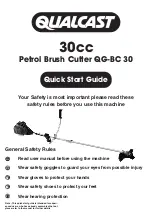
Things to check before using your brushcutter
a. Before beginning work, look around carefully to get a feel for the shape of the land
or grass to be trimmed and whether or not there are any obstacle which might get in
the way white working, and remove any obstacles,
which can be cleared away.
b. The area within a perimeter of 15m of the person us-
ing the brush cutter should be considered a hazardous
area into which no one should enter while the brush
cutter is in use, and when necessary yellow warning
rope, warning signs should be placed around the work
area. When work is to be performed simultaneously by
two or more persons always check the presence and
locations of others so as to maintain a distance each
person.
c. Make sure that there are no loose screws or bolts.
fuel leaks, ruptures, dents, or
any other problems, which might interfere with safe op-
eration. Be especially careful to check that there is
nothing wrong with the blades or with the joints by
which the blades are attached to the brush cutter.
d. Never use blades that are bent, warped, cracked,
broken or damaged in any way.
e. Keep the blade always sharp.
f. Filling the cutting edges, keep the end corner sharp
and round the root of the edge.
g. Check the boll to fasten the blade and be sure the
blade turns smoothly without abnormal noise.
Notes on starting the engine
1. Take a careful look around to make sure that no obstacles exist within a perimeter
of
15m or less around brush cutter.
2. Place the body of the brush cutter onto the ground in a flat clear area and hold it
firmly in place so as to ensure that neither the blades nor the throttle come into con-
tact with any obstacles when the engine starts up.
3. Place the throttle into the idling position when starting the engine.
4. After starting up the engine, if the blades continue to rotate even after the throttle
has been moved fully back, turn off the engine and check the throttle wire and other
parts.
Kickback safety precautions
A dangerous reaction may occur when the spinning blade contacts a solid object in
the critical area. It is called kickback. as a result, the operator can lose control of the
unit, which can cause serious or fatal injury. Avoid kickback, observe the safely pre-
cautions below strictly:
© by WilTec Wildanger Technik GmbH
Seite 26
http://www.WilTec.de
http://www.aoyue.eu
http://www.teichtip.de



































